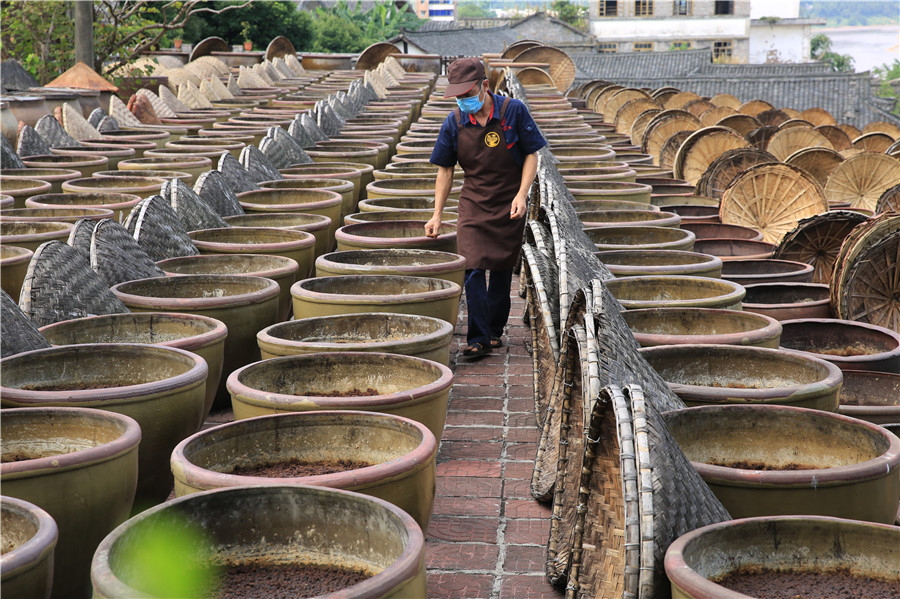Soy sauce is one of the Oriental fermented food products. It is very common in Asiatic countries especially China, Korea, and Japan. Soy sauce is a dark brown liquid condiment with both salty and meaty taste. It also has a peculiar aroma to it. Originally, soybean sauce was first prepared in China over thousand years ago. This condiment also imparts a pleasant colour to the food item and has a rich satisfying flavour.
In this article we will see How soy sauce is made? Basically, the sauce made from the fermented soy beans. In soy sauce preparation the important step of soy sauce process technology is the fermentation stage. Fermentation is two stage process in which carbohydrates and proteins breakdown into compounds which imparts all the characteristic taste and flavour to the finished product. Soy sauce has become very popular not only in asiatic countries but also in other regions across the world.

How Soy Sauce is made:
1)Traditional Method
This process has three stages: “Koji” production, brine fermentation, and refining of the product.
‘Koji’ Production
This is the first step in the manufacturing of soy sauce. The soybeans or defatted soybeans are let to soak in water and then mixed in with the roasted broken wheat. Then this mixture is inoculated with a mold namely, Aspergillus orizae. They are incubated under controlled temperature (25°C) for 3 days. The koji mass becomes green in colour due to sporulation and mold growth.
It becomes a source of proteolytic and amylolytic enzymes. It is the base of the secondary fermentation for the breakdown of proteins and carbohydrates. Koji releases enzymes like protease and amylase. This causes the wheat and soy proteins to breakdown into amino acids and peptides. It also converts the starch present in wheat to sugars. This helps in imparting sweetness to the sauce.
Brine Fermentation
When the Koji fermentation is completed, the water and salt mixed to make a brine solution. Koji then mixed with this solution and transferred to a fermentation tank. It allows the mixture to ferment with added yeast and lactic acid bacteria in a controlled environment and occasional aeration. Aeration helps in mixing the contents and stimulates microbial growth. This slurry is also called ‘moromi’.
During this period, enzymes such as protease from Koji break down the proteins present in soybean and wheat. They break down into peptides and amino acids. Starch converts into simple sugars which ferments to produce lactic acid, carbon dioxide, and alcohol. Due to this, the pH of the mixture drops from near-neutral to 4.7- 4.8. The fermentation tanks holds the brined mash for about 6 to 8 months.
Refining
This is the final step of this process, in which ‘moromi’ pressed to separate from the sauce. Followed by filtration and clarification of the sauce. After that, pasteurization takes place at 70 – 80°C. Pasteurization helps in developing the characteristic aroma and colour of the sauce. It also inactivates the residual undesirable microbes and residual enzymes. After the final clarification process, the sauce packed in clean glass bottles or plastic containers.
In addition, there is another process of soy sauce preparation is Chemical method. Lets see about chemical method below.
2) Chemical Method
Chemical production of soy sauce is very much possible. This process is acid hydrolysis of soybeans (or defatted soybeans). This process does not require the preparation of “koji” and solely relies on food grade hydrochloric acid. It hydrolyzes the proteins present in the soybeans by heating hydrochloric acid and soybeans together. This significantly increases the speed of this process and takes only a few days to produce soy sauce. The hydrolysate neutralizes with sodium carbonate or sodium hydroxide. To refine This acid – hydrolyzed soy sauce, it undergoes sedimentation process. It is also passes through a filter press to eliminate undesirable components and also a high vacuum to get rid of volatile elements that are not desirable.
It is available at cheaper costs and is less attractive in terms of flavour and aroma. Moreover, The aromatic substances such as the carbonyl compounds, alcohols and esters are absent because there is no fermentation process in this method.
Source:




Pingback: Are Fortified Food the same as Functional food? – thefoodtechnologist